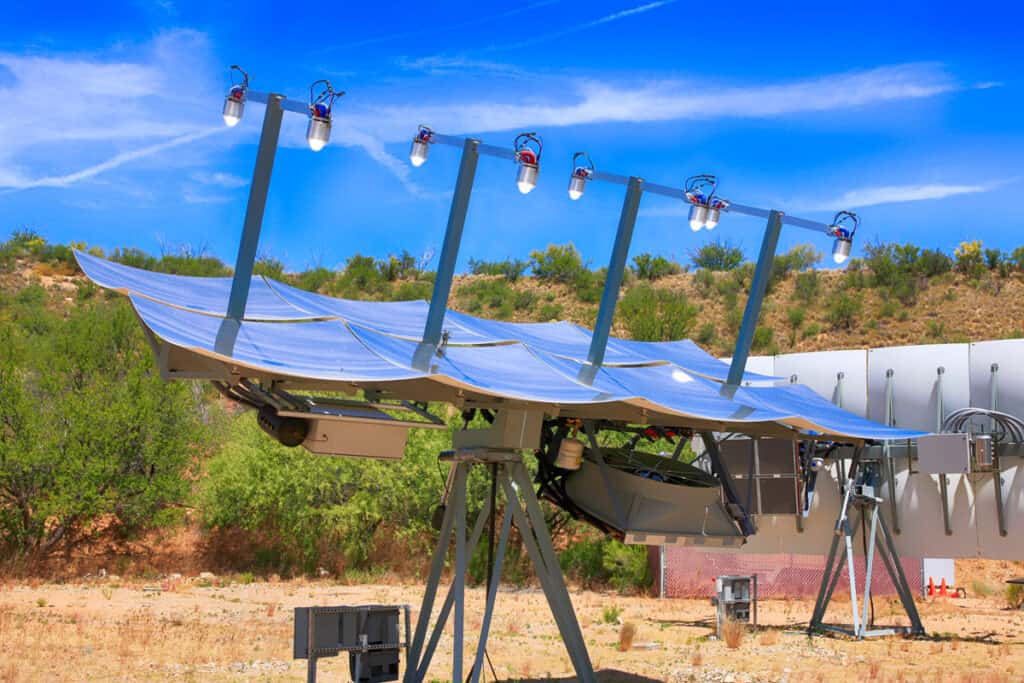The landscape of concentrated solar power (CSP) technology is rapidly evolving, with innovations transforming how we harness solar energy. Understanding CSP vs. photovoltaic systems helps contextualize these advances within the broader renewable energy sector while highlighting the unique advantages that make CSP an increasingly attractive option for large-scale power generation.
Current Technology Advancements
Recent innovations in concentrated solar power have revolutionized the industry’s efficiency and reliability. Solid particle receivers represent a significant breakthrough, allowing higher operating temperatures and improved energy conversion rates. These systems use ceramic particles that can withstand extreme temperatures, enabling more efficient power generation and longer operational lifespans.
Smart control systems have dramatically improved plant operations, using artificial intelligence and machine learning to optimize mirror positioning and energy production. These advances and improved mirror designs featuring enhanced reflectivity and durability have significantly increased system efficiency. The integration of these technologies has led to substantial improvements in overall plant performance and reliability.
Innovative Storage Solutions
The development of advanced thermal storage solutions has increased flexibility in site selection for concentrated solar power facilities. Modern molten salt systems can now maintain higher temperatures for longer periods, significantly improving storage capacity and plant flexibility. This advancement has particularly important implications for regions with variable solar resources or high evening power demand.
Phase change materials represent another frontier in thermal storage, offering higher energy density and more stable temperature control. These materials can store and release large amounts of energy while maintaining consistent temperatures, making them ideal for next-generation CSP plants. The development of hybrid storage systems combining multiple technologies provides even greater flexibility and reliability in power delivery.
Efficiency Improvements
Recent concentrated solar power investment guides highlight the importance of efficiency improvements in making CSP more commercially viable. Enhanced receiver designs now capture more solar energy while minimizing heat loss, while advanced tracking systems ensure optimal solar collection throughout the day. These improvements have significantly increased the economic competitiveness of CSP technology.
Power cycle improvements have also contributed to higher overall system efficiency. Supercritical CO2 cycles, for instance, offer higher thermal efficiency than traditional steam cycles while requiring smaller equipment footprints. This advancement not only improves performance but also reduces construction and maintenance costs.
Integration Technologies
Modern CSP plants increasingly incorporate sophisticated grid integration systems that enable seamless power delivery. Hybrid power plants combining CSP with other renewable technologies demonstrate how innovations in concentrated solar power can complement existing energy infrastructure. This integration capability makes CSP particularly valuable for grid stability and reliability.
Smart control algorithms optimize plant operations in real time, adjusting to changing weather conditions and energy demand patterns. These systems ensure maximum efficiency while maintaining grid stability and meeting power delivery commitments. The ability to predict and respond to varying conditions has dramatically improved plant reliability and economic performance.
Future Developments
The future of CSP technology looks promising, with several emerging trends shaping its development. Next-generation receivers using novel materials and designs promise even higher operating temperatures and efficiency. Advanced materials research continues to yield new solutions for thermal storage and heat transfer applications, pushing the boundaries of what’s possible in solar energy conversion.
Artificial intelligence and automation are increasingly central to CSP plant operation, optimizing everything from mirror positioning to maintenance scheduling. These technologies help reduce operating costs while improving plant reliability and performance. The integration of machine learning algorithms has enabled predictive maintenance and enhanced operational efficiency across all aspects of plant operation.
Environmental Impact
Modern CSP plants demonstrate significant environmental improvements over earlier designs. Advanced dry cooling systems have dramatically reduced water consumption, while smart design approaches minimize land use impact. Wildlife protection measures, including advanced monitoring systems and protective barriers, help maintain local ecosystem balance while ensuring efficient power generation.
The integration of sustainable materials and manufacturing processes further reduces the environmental footprint of CSP facilities. Combined with zero-emission operation, these improvements make CSP an increasingly attractive option for large-scale renewable energy generation. The ability to provide reliable, clean power while minimizing environmental impact has become a crucial advantage for CSP technology.

Conclusion
The ongoing development of new materials, control systems, and storage solutions continues to push the boundaries of what’s possible with concentrated solar power. Through continued innovation and development, CSP technology is becoming more efficient, cost-effective, and environmentally friendly. These advances suggest a bright future for concentrated solar power in the global energy landscape. The combination of improved efficiency, enhanced storage capabilities, and reduced environmental impact positions CSP as a key technology in the transition to renewable energy.

Leave a Reply